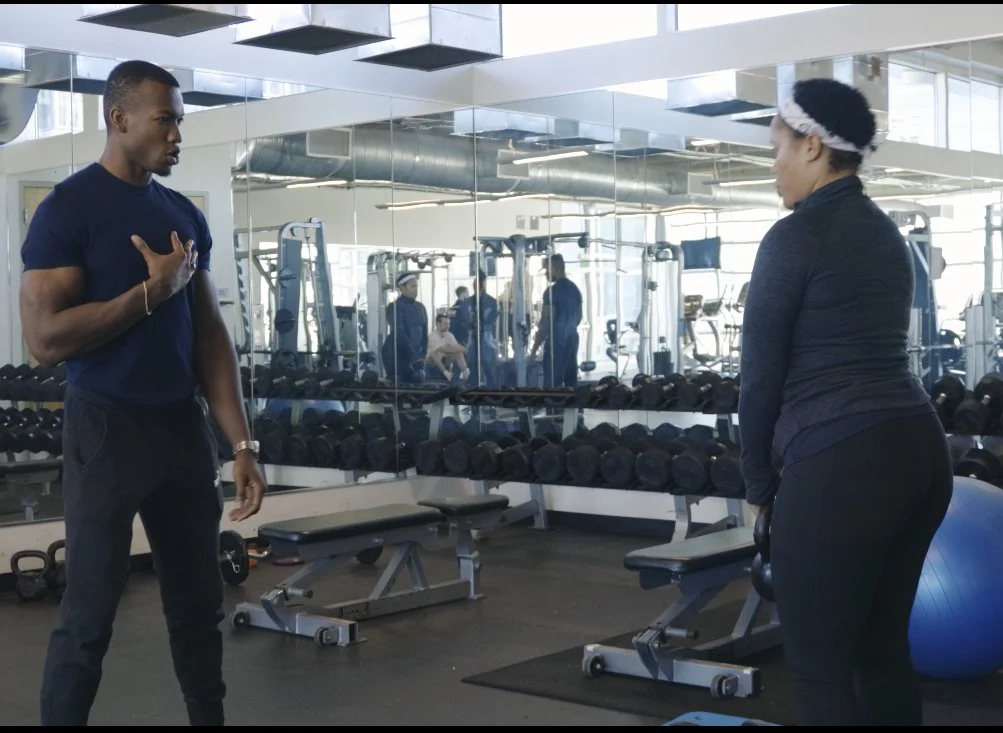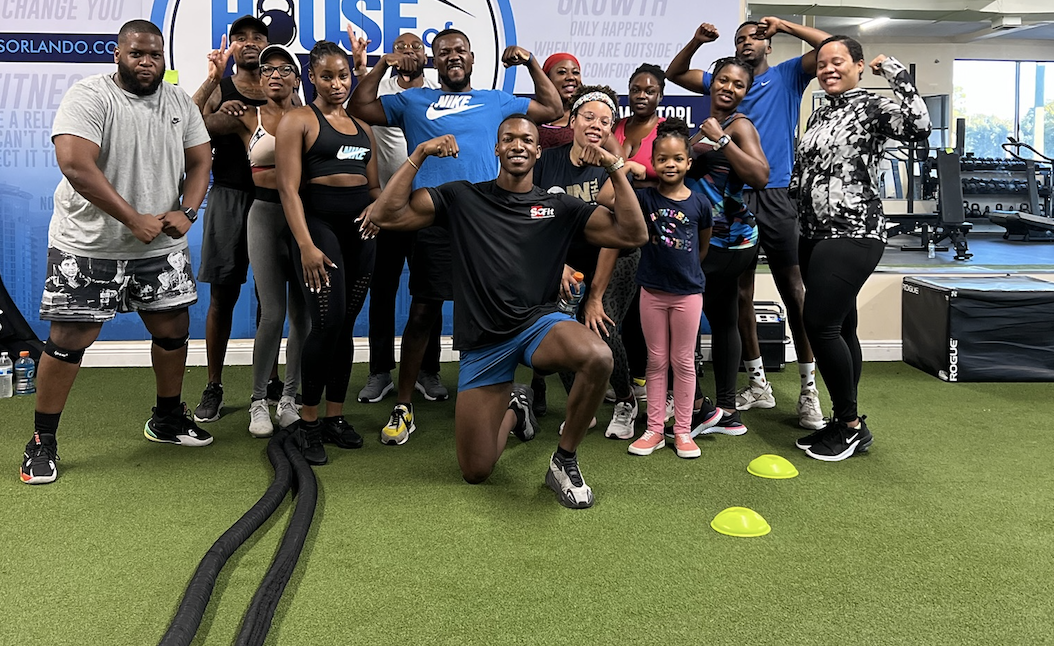What Exactly Does a Personal Trainer Do?
Alt Tag: The trainer is encouraging the client, who is lifting a kettlebell with determination.
I. Introduction
Let’s get this out of the way: personal trainers aren’t just for Hollywood stars or gym junkies chasing six-packs. The modern personal trainer is a wellness strategist, a motivator-in-chief, and yes, sometimes, your unofficial therapist with a stopwatch.
Gone are the days of drill-sergeant stereotypes. Today’s personal trainers are holistic health partners, helping clients move better, feel stronger, and live fuller. From creating tailored workout routines to offering lifestyle tips that actually stick, they’re here for the long haul—not just the highlight reel.
In this blog, we’ll pull back the curtain and dive deep into what personal trainers actually do—from designing personalized fitness plans to being your biggest cheerleader. If you’ve ever wondered whether hiring a trainer is worth it, this might be the push you’ve been waiting for.
II. The Core of the Craft: Primary Responsibilities of a Personal Trainer
1. Initial Fitness Assessments
Before the sweat starts, it’s all about strategy. A good personal trainer begins by taking stock of your current fitness level, health history, and goals. Are you bouncing back from an injury? Chasing a PR? Looking to move pain-free again? These assessments—whether physical tests, movement screens, or lifestyle questionnaires—lay the foundation for a plan that’s both safe and effective.
2. Designing Personalized Workout Plans
No cookie-cutter routines here. Based on your assessment, trainers create customized programs that fit your body and your goals—be it fat loss, muscle gain, increased mobility, or all of the above. And as you progress (or hit a slump), your trainer adapts the program to keep you challenged and on track.
3. Exercise Instruction and Supervision
Form is everything. Personal trainers don’t just show you what to do—they show you how to do it. From the angle of your squat to the rhythm of your breathing, they coach you through every rep, ensuring you move efficiently and avoid injury. Think of them as your personal form police, minus the ticket book.
4. Motivating and Mentoring
Let’s face it—motivation isn’t always on tap. That’s where a personal trainer steps in as your hype squad. They help you push past mental roadblocks, celebrate small wins, and keep the fire lit on days when you'd rather be on the couch. It’s not just about counting reps—it’s about shifting your mindset.
5. Progress Tracking and Reassessment
Goals without tracking? Just guesses. Trainers use tools—think body composition metrics, strength tests, endurance checks—to monitor progress. Regular check-ins help identify what’s working and what needs tweaking. The result? You stay focused, and your program stays effective.
6. Offering Lifestyle and Nutrition Guidance
True fitness lives beyond the gym. While personal trainers may not craft detailed meal plans unless certified in nutrition, many offer sound, practical advice around eating habits, sleep hygiene, stress management, and daily activity. It’s about building habits that support your workouts—not sabotage them.
7. Implementing Safety Protocols
A solid session is a safe session. Trainers ensure equipment is used correctly, demonstrate proper warm-ups and cool-downs, and remain prepared for emergencies with CPR or first aid certification. They create an environment where you can push your limits without risking your safety.
III. Beyond the Workout: Additional Roles and Responsibilities
Alt Tag: Additional roles and responsibilities of a personal trainer
A great personal trainer does more than count reps and shout encouragement. Their impact extends beyond the one-on-one session—and sometimes, beyond the gym floor.
Leading Group Classes or Bootcamps
Whether it’s a high-energy HIIT bootcamp or a small-group strength session, personal trainers often step into the role of group leader. Here, they flex their coaching skills on a broader scale—managing energy, pace, and diverse fitness levels in a single room. It’s where crowd control meets charisma.
Keeping Up with Trends
The fitness world evolves fast—from mobility flow sessions to the latest wearable tech that tracks recovery down to the heartbeat. Personal trainers stay current with new methods, certifications, and tools to keep your workouts relevant, evidence-based, and, yes, exciting.
Building Rapport and Client Loyalty
This is where the magic really happens. A strong trainer-client bond is built on trust, communication, and mutual respect. Great trainers remember your birthday and your bench press max. They know when to push, when to pull back, and how to make you feel seen—not just trained.
Supporting Gym Operations or Selling Training Packages
In commercial gyms, trainers often wear many hats. Beyond coaching, they may help manage schedules, introduce new members to equipment, or even support gym marketing by offering intro sessions. And yes, selling training packages is often part of the gig. But the best trainers sell through value, not pressure.
IV. Why It Matters: The Benefits of Hiring a Personal Trainer
Still wondering if hiring a trainer is worth it? Let’s break down why the investment pays off—far beyond the price of a single session.
Making Workouts Effective and Fun
Ever wandered aimlessly around a gym unsure where to start? A personal trainer replaces confusion with clarity—and repetition with results. They’ll craft sessions that challenge your body and keep your brain engaged, transforming workouts from something you have to do into something you might actually look forward to.
Accountability and Structure
It’s easy to skip the gym when no one’s watching. But when you’ve got a trainer waiting—and cheering—you show up. That built-in accountability keeps you consistent. Combine that with a structured plan that evolves with your progress, and you’ve got a recipe for sustainable success.
Achieving Long-Term Health Outcomes
This isn’t just about aesthetics. Regular, guided workouts can improve heart health, blood pressure, posture, joint mobility, and mental clarity. A trainer helps you build lean muscle, improve cardiovascular fitness, and reduce injury risk—all while teaching habits that support long-term wellness.
V. Where You’ll Find Them: Common Work Settings
Personal trainers are everywhere these days—and we mean everywhere. The role has evolved far beyond the traditional gym setup, expanding to meet clients wherever they are (physically and digitally).
Gyms and Fitness Studios
The classic setting. Gyms and boutique fitness studios offer personal trainers a structured environment, access to a variety of equipment, and a steady stream of clients. Here, trainers often work with a diverse clientele—from first-timers to long-time lifters.
In-Home Training
Want the gym to come to you? Many trainers offer in-home sessions, bringing equipment and expertise right to your living room. This setup is ideal for clients who prefer privacy, convenience, or personalized attention without the distractions of a commercial gym.
Online Platforms
From Zoom sessions to fully customized app-based programs, online training has exploded. Trainers now reach clients globally, offering flexibility in time, location, and delivery. It’s personal training, reimagined for the digital age.
Solo Entrepreneurs vs. Corporate Trainers
Some trainers operate independently—building personal brands, managing their own client base, and crafting custom services. Others work under the umbrella of large fitness corporations or franchises. Both paths have perks: independence vs. infrastructure, entrepreneurial hustle vs. corporate stability.
VI. The Must-Haves: Key Skills and Qualifications
A personal trainer is part coach, part educator, part motivator. To juggle all those hats, they need a balanced skillset that blends hard science with soft finesse.
Soft Skills: Communication, Empathy, and Motivational Flair
No one wants a drill sergeant barking orders with zero emotional IQ. The best trainers listen deeply, read the room, and know how to inspire without intimidating. They’re masters of encouragement, quick to adapt their style to match each client’s needs and mindset.
Hard Skills: Fitness Knowledge and Professional Certifications
Knowing your deadlifts from your dumbbell rows is just the start. Top-tier trainers are grounded in exercise science, human anatomy, and program design. Most hold certifications from respected organizations like NASM (National Academy of Sports Medicine), ACE (American Council on Exercise), or NSCA (National Strength and Conditioning Association). These credentials aren’t just letters—they signal a serious commitment to quality.
Ethics and Professionalism
Confidentiality. Punctuality. Boundaries. The behind-the-scenes traits that build long-term trust. Great trainers uphold a code of conduct that puts client safety and well-being above all. They’re not just in your corner for squats—they’re in it for your growth, on every level.
VII. Conclusion
At the end of the day, personal trainers aren’t just fitness guides—they’re strategic partners in your wellness journey. From your first assessment to every drop of sweat that follows, they’re there to help you move with purpose, train with intention, and live with more energy, confidence, and clarity.
They design the plan, teach the moves, adjust for your real life, and cheer you on when motivation hits a low. Whether you're chasing performance goals or simply trying to feel better in your own skin, a personal trainer brings structure, support, and expertise that’s hard to match on your own.
Thinking about working with one? Look for someone who listens first, communicates clearly, holds reputable certifications, and has a coaching style that fits your vibe. This isn’t just about fitness—it’s about finding someone who can help unlock your potential, one session at a time.
Frequently Asked Questions (FAQ)
1. Do I need to be fit before hiring a personal trainer?
Not at all. Personal trainers work with people at all fitness levels—from complete beginners to seasoned athletes. In fact, starting with a trainer can help you build a strong foundation safely and effectively.
2. How often should I see a personal trainer?
It depends on your goals, schedule, and budget. Some clients train multiple times a week, while others check in once every week or two for accountability and program updates. Your trainer will help you find the right rhythm.
3. Can a personal trainer help with weight loss?
Yes, but more importantly, they help with sustainable weight loss. Trainers combine exercise guidance with lifestyle and habit coaching to support fat loss, muscle gain, and overall health—not just quick fixes.
4. What qualifications should I look for in a trainer?
Look for certifications from reputable organizations like NASM, ACE, or NSCA. Also consider experience, client reviews, and whether their communication style and training approach align with your needs.
5. Is hiring a personal trainer worth the investment?
If you're looking for personalized support, expert guidance, and long-term results—it absolutely is. A good trainer can help you avoid injuries, stay motivated, and make real, lasting progress toward your fitness goals.
VIII. References & Resources
The insights in this article were drawn from trusted sources in fitness education, career guidance, and health publishing. For further reading or to explore these topics in more depth, check out the full list below:
https://www.zippia.com/personal-trainer-jobs/what-does-a-personal-trainer-do
https://www.health.harvard.edu/exercise-and-fitness/how-a-personal-trainer-can-enhance-your-workouts
https://www.prospects.ac.uk/job-profiles/personal-trainer
https://www.insure4sport.co.uk/blog/how-to-blog-as-a-personal-trainer/
https://resources.workable.com/personal-trainer-job-description
https://instituteofpersonaltrainers.com/write-a-how-to-blog-post
https://traineracademy.org/training/personal-trainer-job-description/
With Sofit Personal Training’s expertise and support, you’re well on your way to finding a great personal trainer to help you with your journey. Reach out if you need any help.



